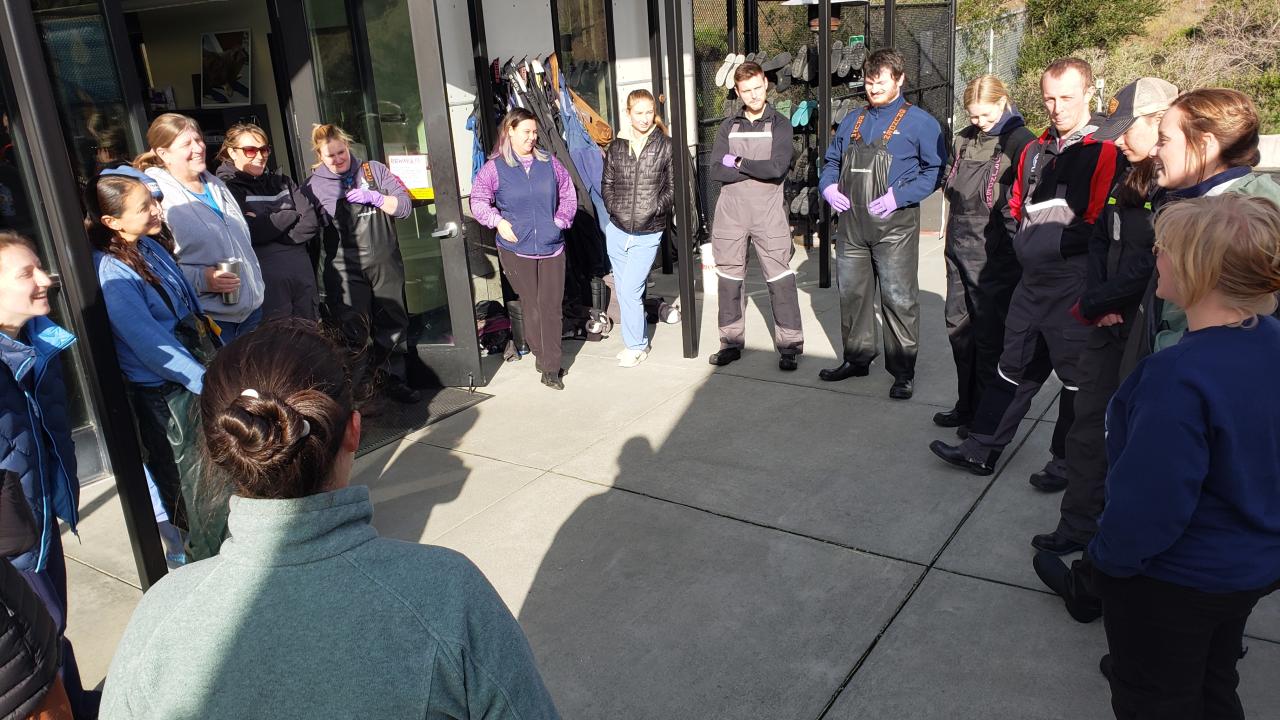
Shared Knowledge, Shared Impact: The Power of Learning in Marine Mammal Care
I’ve done this dozens of times, but my adrenaline skyrockets nonetheless. His wide, unblinking eyes glare at me, his chest heaving with sharp but rhythmic breaths. He tracks my slow, deliberate movements. He watches for any sudden move I make, but still, he lets me approach. Two other team members hold wooden boards between us and him for protection- after all, he outweighs the three of us combined, and his teeth could turn us into quite the plastic surgeon’s dream.
One more step…slow…steady…then in a swift motion, I lunge forward, pole syringe in hand, depressing it into his chocolate brown fur with just enough pressure to trigger the spring mechanism. For a split second, I move with him, which is long enough to deliver the sedative into his gluteal muscles. I carefully withdraw the needle from his limb and our team from his enclosure.
Then we wait. From a distance, we watch as he fights the sedative, his head drooping lower…lower. Eventually, he rests flat on the ground, breathing deeply, now fully asleep.
Approaching carefully, we tap his hind flipper, tug on his front flipper, and finally gently lift his head to confirm his depth of sedation. Once certain, we slip a modified traffic cone over his face, taking extra care not to bend his whiskers, and allow the gas anesthesia to flow steadily into his nostrils as he continues to inhale deep, anesthetic-laced breaths.
This adult male California sea lion, like many patients here, is undergoing anesthesia for a medical examination. And today, I’m part of a clinical team tasked with determining the cause of his stranding and formulating a treatment plan for his hopeful return to the ocean.
Over the past eight months, I’ve been incredibly fortunate to be able to participate intermittently as a clinical veterinarian alongside the amazing marine mammal veterinary team (Dr. Emily Whitmer, and RVTs Sarah Pattison, Sophie Guarasci, Lauren Campbell, Amy Rubenstein, Kelly Miller, and Liz Eby), some of the most dedicated professionals in marine mammal care. Being able to partner in this way with The Marine Mammal Center (TMMC), one of our longest-standing Member Organizations, has been a deeply rewarding experience. Not only has it allowed me to maintain and sharpen my clinical skills, but it’s also provided invaluable opportunities to engage with a passionate and expert veterinary team that is making a difference every day in the lives of marine mammals.
This hands-on work has been pivotal in keeping my skills as a clinical marine mammal veterinarian sharp and current. Whether it's conducting medical examinations, managing anesthesia, or working through clinical cases, each day at TMMC brings something new and exciting. But beyond the technical skills, the opportunity to strengthen relationships with the TMMC team has been equally important. The collaborative environment has created a space for meaningful conversations and coordination between our teams, enabling us to work together to refine processes and improve protocols for oiled marine mammal care.
Another aspect of my year that I look forward to is being a co-leader for Marine Mammal Week in the veterinary student curriculum. Each year, I partner with Dr. Cara Field from TMMC to design a week of presentations, hands-on activities, and real-world assignments that immerse students in marine mammal care. The week culminates in a field trip to TMMC, where students have the chance to observe and participate hands-on in both clinical cases and necropsy. From assisting with medical examinations and necropsy to discussing real cases with the clinical and pathology teams, it’s an experience that helps these future veterinarians gain a practical understanding of the complexities of marine mammal medicine.

By blending these two experiences—the clinical work at TMMC and educating the next generation of veterinarians—I’m able to stay connected to both the daily realities of marine mammal care and the ongoing evolution of veterinary medicine. This also allows me to contribute to important work in the realm of oiled wildlife response, from updating key protocols such as the “Protocols for the Care of Oil-Affected Otters”, to reflect the most current standards, to writing new ones, such as “The Marine Mammal Center Deployment and Activation Plan,” a comprehensive plan that ensures TMMC is ready to respond quickly and efficiently in the event of an oil spill involving marine mammals.
In a field where collaboration and quick action are essential, I’m grateful for the opportunity to contribute to these ongoing efforts. The chance to work with such a talented team at TMMC, and to play a role in educating the next generation of marine mammal veterinarians, is a privilege I do not take lightly. It’s an experience that continually fuels my passion for wildlife medicine and reminds me of why I chose this path in the first place—because every animal, every case, and every student is an opportunity to make a lasting impact on the conservation of these incredible species.
